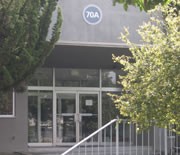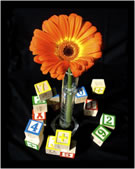


 Bldg. 70A is a repeat winner for the Director’s Carbon Cycle 2.0 Building Energy Savings Challenge, with a 37.8 percent reduction in energy usage in the 12 months ending in May 2010 compared to the FY 2008 baseline. Bldg. 70A had previously won the Energy Savings Challenge in February, the first month of the contest. In second place for May is Bldg. 54, which achieved a 34.0 percent savings, followed by Bldg. 55, which achieved a 9.6 percent savings. Both are also previous winners. None of these three buildings has major ongoing construction activities nor has any experienced planned or unforeseen outages.
Bldg. 70A is a repeat winner for the Director’s Carbon Cycle 2.0 Building Energy Savings Challenge, with a 37.8 percent reduction in energy usage in the 12 months ending in May 2010 compared to the FY 2008 baseline. Bldg. 70A had previously won the Energy Savings Challenge in February, the first month of the contest. In second place for May is Bldg. 54, which achieved a 34.0 percent savings, followed by Bldg. 55, which achieved a 9.6 percent savings. Both are also previous winners. None of these three buildings has major ongoing construction activities nor has any experienced planned or unforeseen outages.
Each month, the Energy Challenge will honor the top three Berkeley Lab buildings with the greatest improvements in energy savings. The building with greatest improvement after six months will be treated to a lunch for the entire building, hosted by Lab Director Paul Alivisatos. More>
 Mina Bissell, Distinguished Scientist with the Life Sciences Division, has won the American-Italian Cancer Foundation's Prize for Scientific Excellence in Medicine, which recognizes important discoveries in cancer biology, prevention, diagnosis, and/or treatment. Bissell received the prize, which includes a $50,000 cash award, for “having changed the accepted paradigms in cancer research, for pioneering the field of Tumor Microenvironment, and for the courage to persist.” She is scheduled to receive the award at the AICF’s 30th anniversary meeting in New York City on November 8. She will deliver a lecture at the meeting the following day. Click here for more about the AICF.
Mina Bissell, Distinguished Scientist with the Life Sciences Division, has won the American-Italian Cancer Foundation's Prize for Scientific Excellence in Medicine, which recognizes important discoveries in cancer biology, prevention, diagnosis, and/or treatment. Bissell received the prize, which includes a $50,000 cash award, for “having changed the accepted paradigms in cancer research, for pioneering the field of Tumor Microenvironment, and for the courage to persist.” She is scheduled to receive the award at the AICF’s 30th anniversary meeting in New York City on November 8. She will deliver a lecture at the meeting the following day. Click here for more about the AICF.
 Molecular Foundry scientist Ron Zuckermann is featured as a guest blogger this week at ScriptPhD.com, a blog covering science and technology across the spectrum of entertainment, media, and pop culture. Zuckermann's article, "Beauty and the Building Blocks," details his life’s mission as a chemist, designing artificial microscale sheets made up of nature’s very own building blocks—proteins. More>
Molecular Foundry scientist Ron Zuckermann is featured as a guest blogger this week at ScriptPhD.com, a blog covering science and technology across the spectrum of entertainment, media, and pop culture. Zuckermann's article, "Beauty and the Building Blocks," details his life’s mission as a chemist, designing artificial microscale sheets made up of nature’s very own building blocks—proteins. More>
![]() [Federal Computer Week] The Energy Department's Lawrence Berkeley National Laboratory is moving its e-mail to Google’s cloud-based Gmail system to obtain improved functionality and a reduced cost of operation. “We looked at functionality, and we liked Google,” Lab Chief Information Officer Rosio Alvarez said. Regarding cost, the new Gmail system will save $1 million to $2 million over five years, she said. The Energy Department is currently operating a pilot project to see if it will adopt Gmail as well, and a decision is expected in the fall, Alvarez said. More>
[Federal Computer Week] The Energy Department's Lawrence Berkeley National Laboratory is moving its e-mail to Google’s cloud-based Gmail system to obtain improved functionality and a reduced cost of operation. “We looked at functionality, and we liked Google,” Lab Chief Information Officer Rosio Alvarez said. Regarding cost, the new Gmail system will save $1 million to $2 million over five years, she said. The Energy Department is currently operating a pilot project to see if it will adopt Gmail as well, and a decision is expected in the fall, Alvarez said. More>
[New York Times Green Blog] The authors compiled a database of 1,372 climate researchers. They then focused on scientists who had published at least 20 papers on climate, as a way to concentrate on those most active in the field. That produced a list of 908 researchers whose work was subjected to close scrutiny. The authors then classified those researchers as convinced or unconvinced by the evidence for human-induced climate change. Then the authors analyzed how often each scientist had been published in the climate-science literature, as well as how often each had been cited in other papers. The results are pretty conclusive. More>
 The Advanced Light Source (ALS) User Support Building, a three-story, 30,928 gross-square-foot building, is advancing toward completion, scheduled for July 2011. The building will house experiment assembly spaces, conference rooms, offices and labs for some 80 researchers. The $35-million project is funded by DOE Office of Science, with $14.7 million of it coming from the American Recovery and Reinvestment Act. For more information go here.
The Advanced Light Source (ALS) User Support Building, a three-story, 30,928 gross-square-foot building, is advancing toward completion, scheduled for July 2011. The building will house experiment assembly spaces, conference rooms, offices and labs for some 80 researchers. The $35-million project is funded by DOE Office of Science, with $14.7 million of it coming from the American Recovery and Reinvestment Act. For more information go here.
 The Health Care Facilitator wants to remind employees that June is “National Safety Month.” One of the most common work injuries is a fall. Identifying risks and injury-prevention measures are the first steps in reducing or eliminating fall hazards. To help keep yourself and co-workers safe, be sure to wear sensible footwear, keep hallways and workspaces clutter-free, clean up spills immediately, and maintain good lighting. Most falls are preventable. Take precautions to reduce your risk.
The Health Care Facilitator wants to remind employees that June is “National Safety Month.” One of the most common work injuries is a fall. Identifying risks and injury-prevention measures are the first steps in reducing or eliminating fall hazards. To help keep yourself and co-workers safe, be sure to wear sensible footwear, keep hallways and workspaces clutter-free, clean up spills immediately, and maintain good lighting. Most falls are preventable. Take precautions to reduce your risk.
Today
at Berkeley Lab encourages feedback and story ideas
Deadline for submissions is 10 a.m. two days prior to publication
TABL is produced by Public Affairs' Communications Group